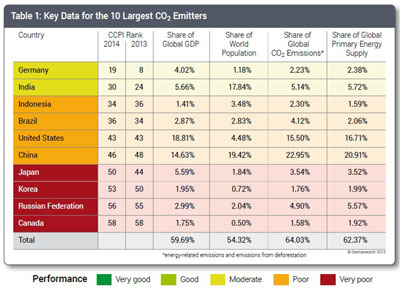In 2012, global greenhouse gas emissions continued their trajectory to all-time highs, but some researchers are cautiously optimistic that the world is edging closer to a plateau.
"Unexpectedly, for the first time our Index draws a cautious picture of hope", says Jan Burck, an author of the annual Climate Change Performance Index by Bonn-based Germanwatch and Climate Action Network Europe (CAN-E).
It’s not that emissions are coming down, but "We see positive signals toward a slowdown in the increase in global CO2 emissions.
That’s largely because China- the world’s biggest emitter- has improved on climate protection. From 2002-2012 China accounted for about four-fifths of the world’s growth of carbon emissions.
Although world carbon emissions rose 1.4% last year – to a record 31.6 gigatons – that was less than half the 2011 rise of 3.2%.
The index, which ranks the top 58 climate-polluting countries (1 is the least polluting, 58 is the biggest polluter), ranks China as #46 this year, from #48 in 2012. After peaking in 2012, China’s growth in emissions slowed this year – emissions grew by 27% compared to 54% last year.
As we recently wrote, a key to solving the climate change dilemma may be in addressing what’s more tangible – air pollution.
With its cities choked by smog, China has begun to implement an air pollution action plan, which will force major provinces to cut back on coal. Also important are the cap-and-trade pilot programs, now underway in several cities, and its aggressive moves on solar and wind installations.
In 2012, China – for the first time – increased power production from wind more than from coal.
"Record air pollution has changed the discussion about coal, and now prominent policymakers and opinion leaders, even vice-ministers, call for capping coal use, especially in the eastern populated and industrial areas of China," says Li Shuo, climate and energy campaigner for Greenpeace in Asia.
Which countries are #1, #2, or #3?
Not a single one – because none is on track with policies that would keep temperature rise below 2°C.
Denmark leads the world on cutting carbon pollution, ranking #4, and slightly improved its score on every criterion this year.
It may surprise you the UK takes fifth place (up from #10 last year). Although the country has been tussling with its renewable energy subsidies, it has cut emissions 15% in the last five years. Portugal is #6 (up from #7 last year).
So where is Germany – the country we hear the most about?
For the first time, Germany dropped out of the top 10 – slipping from #8 to #19 – one of the biggest losers in this year’s index. Incredibly, this long-time renewable energy leader is using more coal and has been "less constructive in the EU energy debate, blocking urgently needed reforms in the cap-and-trade program."
On the bright side, Morocco has moved up to #15 because of its national climate change plan and recent moves to install a series of gigantic solar projects. And that’s in a country that still has relatively low emissions.
As for the US, we are way down the list at #43 for two years in a row, even with our emissions declining 8% in the last five years. That’s because the US is far from truly taking proactive measures on climate and energy.
"The US government shows more stringency in climate policy than in the last legislative period," they say, because of policies that are improving fuel economy and new regulations on coal fired plants. The US is also playing a constructive role on phasing out HFCs.
It’s a shame that Canada comes in dead last at #58 for the second year (among industrialized countries). Known for decades as one of the world’s most environmentally conscious countries, it has turned solidly toward exploitation of tar sands, minerals and a lack of interest on climate policy.
With the election of a far-right administration, Australia also slid this year, taking the second-to-last slot – #57. Last year, Australia ranked #51, but it is now in the process of dismantling its pioneering carb tax, which was just getting off the ground (along with most other carbon reduction efforts).

Unfortunately, "The latest UNEP Emissions Gap report shows that current policies of all countries are insufficient to keep the world on a path to stay below 2°C. This should be a wake-up call for all governments to begin speeding up emission reductions," says Wendel Trio, Director of CAN-Europe.
"The European Union and its Member States, though currently high up in the rankings, cannot relax and must increase their 2020 pledge whilst ensuring an ambitious post-2020 target is adopted. Such leadership could help the world to increase action despite the detrimental actions of Australia, Canada and Japan," Trio adds.
The index is designed to enhance transparency in international climate politics. The 58 countries analyzed and compared are together responsible for more than 90% of global energy-related carbon emissions. Methane and other greenhouse gases are not evaluated.
Currently the world is on course for a 3.7°C temperature rise. "We are seeing a major risk of a further downward spiral in ambition, a retreat from action, and a re-carbonisation of the energy system led by the use of coal," warns Bill Hare, director of Climate Analytics, one of three research groups behind the Climate Action Tracker.
Here is the Climate Change Performance Index:
